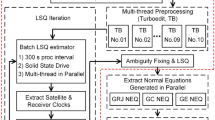Abstract
Previous studies of parallel processing methods for use with satellite related, many parameter estimation problems indicated the need for faster numerical integration methods. A study of parallel numerical integration methods for use in satellite orbit determination showed only slight improvement over the fastest serial methods, thus prompting the reexamination of the role of numerical integration in a parallel estimation scheme. A parallel orbit determination scheme, parallel in both observation processing and least squares solution, was implemented. The fastest parallel method, run on twenty-four processors, showed a 33% improvement over the fastest serial method for the case of estimating twenty-four GPS satellite orbits. To determine the relative time spent in numerical integration a detailed analysis of the time spent in each of the primary steps of the parallel method was completed. This analysis showed that numerical integration does not account for a significant fraction of the computing times. In addition, the analysis revleaed that delays due the the synchronization of processors were a limit on the performance.
Similar content being viewed by others
References
BAKER, G. A. “Geopotential Error Analysis from Satellite Gradiometer and Global Positioning System Observables on Parallel Architectures,” Tech. Rep. CSR 97-5, Center for Space Research, The University of Texas at Austin, October 1997.
NAGEL, P. and SCHUTZ, B. “Parallel Numerical Integration Methods for Orbital Motion,” The Journal of the Astronautical Sciences, Vol. 48, October–December 2000.
TAPLEY, B. D. “Fundamentals of Orbit Determination,” in Theory of Satellite Geodesy and Gravity Field Determination (F. Sanso and R. Rummel, eds.) Vol. 25, pp. 235–260, Springer-Verlag, 1989.
TAPLEY, B. D. “Statistical Orbit Determination Theory,” in Recent Advances in Dynamical Astronomy (B.D. Tapley and V. Szebehely, eds.), pp. 396–425, D. Reidel, 1973.
VAN DE GEIJN, R. A. Using PLAPACK: Parallel Linear Algebra Package, Cambridge: MIT Press, 1997.
CHOI, J., DONGARRA, J., POZO, R., and WALKER, D. W. “Scalapack: A Scalable Linear Algebra Library for Distributed Memory Concurrent Computers,” in Proceedings of the Fourth Symposium on the Frontiers of Massively Parallel Computation, pp. 120–127, IEEE Comput. Soc. Press, 1992.
SNIR, M., OTTO, S. W., HUSS-LEDERMAN, S., WALKER, D. W. and DONGARRA, J. MPI: The Complete Reference, Cambridge: MIT Press, 1996.
RIM, H. J. “TOPEX Orbit Determination Using GPS Tracking System,” Tech. Rep. CSR 92-3, Center for Space Research, The University of Texas at Austin, December 1992.
Author information
Authors and Affiliations
Corresponding author
Rights and permissions
About this article
Cite this article
Nagel, P., Schutz, B.E. An Evaluation of Parallel Least Squares Methods for Multisatellite Orbit Determination. J of Astronaut Sci 50, 231–239 (2002). https://doi.org/10.1007/BF03546264
Published:
Issue Date:
DOI: https://doi.org/10.1007/BF03546264




